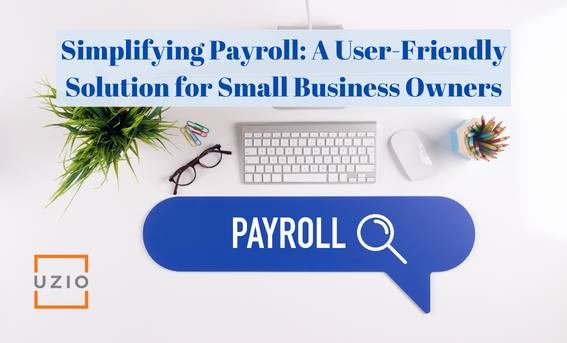
Setting up and Managing a user-friendly Payroll Solution for your Small Business
Quick links
-
Introduction
-
Understanding Payroll Software
-
Features of Payroll Software
-
Choosing the Right Payroll Software for Your Small Business
-
Setting Up Payroll Software for Your Business
-
Case Study and Success Story: UZIO
-
Conclusion
1. Introduction
As a small business owner, managing payroll can be a complex and time-consuming task. Fortunately, there are software solutions available that can help you streamline your payroll processing, save time and money, and ensure compliance with tax regulations and laws.
In this article, we will explore the main aspects of how to set up and manage payroll software for small businesses. We will also discuss how to choose the right software for your business, and how to set it up and use it effectively.
2. Understanding Payroll Software
How does payroll software work?
Payroll software is a type of computer program designed to automate and streamline the process of managing employee pay and taxes. It can handle tasks such as calculating employee wages, deductions, and taxes, generating pay stubs and reports, and submitting tax filings to government agencies.
Payroll software works by integrating with your existing systems and processes to gather data about your employees’ hours, pay rates, and other relevant information. It then performs calculations based on this data to generate accurate paychecks and tax withholdings.
Types of payroll software
There are several types of payroll software available, including:
- Desktop software: This type of software is installed on a computer or server and is managed locally. It can be a good option for small businesses with a reliable IT infrastructure.
- Cloud-based software: This type of software is hosted in the cloud and accessed via a web browser or mobile app. It can be a good option for small businesses that need flexibility and mobility.
- Mobile payroll apps: These are specialized payroll apps that can be downloaded and used on mobile devices such as smartphones and tablets. They are ideal for businesses that need to manage payroll on the go.
- Integrated HR software: Some payroll software solutions are integrated with HR software to offer a complete HR management system.
3. Features of Payroll Software
Basic features of payroll software
Most payroll software solutions will offer basic features such as:
- Paycheck calculation and processing
- Tax withholdings and filings
- Direct deposit
- Reporting and recordkeeping
- Compliance with labor and tax laws
Advanced features of payroll software
Some payroll software solutions will offer advanced features such as:
- Time and attendance tracking
- Employee self-service
- Customizable reporting
Customizable features of payroll software
Many payroll software solutions offer customizable features, allowing you to tailor the software to your specific business needs. These features may include:
- Customizable pay schedules and pay types
- Integration with other software and systems
- Customized reporting and analytics
- Role-based access and permissions
- Customizable tax settings
4. Choosing the Right Payroll Software for Your Small Business
Assessing your payroll needs
Before choosing payroll software, it’s important to assess your payroll needs. This includes considering factors such as:
- Number of employees
- Frequency of pay periods
- Payroll processing complexity
- Budget
Evaluating payroll software options
When evaluating payroll software options, there are several factors to consider, including:
- Cost and pricing structure
- Features and functionality
- Ease of use and user interface
- Customer support and training
- Integration with other systems and software
- Security and compliance
Making a decision
After evaluating your options, you can make an informed decision on which payroll software solution is right for your small business. It’s important to consider not only the features and functionality but also the cost and ease of use.
5. Setting Up Payroll Software for Your Business
Once you’ve chosen the right payroll software for your small business, the next step is to set it up and start using it. While the process may vary slightly depending on the software you choose, there are a few key steps you’ll need to follow to get started.
1. Gather Necessary Information
Before you start setting up your payroll software, it’s important to gather all the necessary information. This may include:
Business details, such as your tax ID number and state and federal tax information
Employee details, including their names, addresses, Social Security numbers, and tax withholding information
Payroll schedule, such as the frequency of pay periods and pay rates for different types of employees
Company policies related to paid time off, overtime, and bonuses.
2. Set Up Employee Profiles
The next step is to set up employee profiles within the payroll software. This typically involves entering basic employee information, such as name, address, and Social Security number, as well as more detailed information such as pay rates, deductions, and tax withholdings.
Some payroll software may also allow you to set up employee self-service portals where employees can update their personal information, view pay stubs and W-2 forms, and request time off.
3. Configure Pay Schedules
Once employee profiles are set up, the next step is to configure pay schedules within the software. This may include setting up regular pay periods, specifying pay rates for different types of employees, and configuring automatic deductions for taxes and other withholdings.
Some payroll software may also allow you to set up different pay rates for different types of work, such as regular hours, overtime, or holiday pay.
4. Enter Employee Hours and Earnings
With employee profiles and pay schedules set up, you can begin entering employee hours and earnings into the software. This will allow the software to calculate wages, taxes, and deductions automatically, and generate paychecks and pay stubs.
Some payroll software may also offer features like direct deposit, allowing you to deposit paychecks directly into employees’ bank accounts.
5. Review and Finalize
Once you’ve entered all necessary information, it’s important to review it carefully and make any necessary adjustments. This will help ensure that your payroll information is accurate and up to date.
Some payroll software may also offer features like automated tax filing, which can help streamline the tax filing process and reduce the risk of errors or penalties.
By following these steps, small business owners can set up payroll software efficiently and effectively, allowing them to streamline their HR processes and focus on growing their business.
Compliance checklist for best practices for implementing payroll software
While setting up payroll software can be a relatively straightforward process, there are a few best practices to keep in mind to ensure that the process goes smoothly and you get the most out of your software:
- Choose a reputable payroll software provider that is compliant with all relevant regulations and standards, such as the Fair Labor Standards Act (FLSA) and the Affordable Care Act (ACA).
- Conduct thorough research to ensure that the payroll software provider offers the features and functionalities required to meet your business needs, such as tax filing and direct deposit.
- Establish clear goals and objectives for the implementation process, including timelines, milestones, and key performance indicators (KPIs).
- Develop a detailed project plan that outlines all tasks and responsibilities, and allocate resources accordingly.
- Conduct a thorough review of all payroll processes to ensure that they are compliant with relevant regulations and standards, and identify areas for improvement.
- Provide adequate training and support to all employees involved in the payroll process, including managers, HR staff, and payroll administrators.
- Ensure that all employees have the necessary access to the payroll software and that all permissions and security settings are appropriately configured.
- Conduct thorough testing and quality assurance to ensure that the payroll software is functioning as expected and that all data is accurate and up-to-date.
- Develop a system for ongoing monitoring and review of payroll data and processes to identify areas for improvement and ensure ongoing compliance with regulations and standards.
- Stay in communication with the payroll software provider and regularly review software updates and new features to ensure that your business is taking advantage of all available resources and functionalities.
By following this compliance checklist for best practices for implementing payroll software, businesses can ensure that they are meeting all relevant regulations and standards, and that their payroll processes are accurate, efficient, and compliant. This can help avoid costly penalties and legal issues, and free up time and resources for other business needs.
With UZIO, small business owners can rest assured that their payroll and HR needs are taken care of, allowing them to focus on what they do best – running their business.
Managing payroll with software
After setting up your payroll software, you can begin using it to manage your payroll. This includes tasks such as:
- Entering employee hours and earnings: Many payroll software solutions allow for easy entry of employee hours and earnings. Some software solutions even integrate with time tracking software, allowing for seamless import of employee hours. By automating this process, businesses can save time and reduce the risk of errors.
- Generating paychecks and pay stubs: Once employee hours and earnings have been entered, payroll software can generate paychecks and pay stubs. These documents can be customized to meet the business’s specific needs and can be easily printed or distributed electronically to employees. This can save time and reduce paper waste.
- Calculating taxes and deductions: Payroll software can accurately calculate taxes and deductions based on employee information and company policies. This can help ensure compliance with federal and state regulations, and can save time by automating these calculations.
- Generating reports and records: Payroll software can generate a variety of reports and records related to payroll, including employee earnings summaries, tax filings, and year-end reports. These reports can help businesses track payroll expenses and ensure compliance with regulatory requirements.
- Submitting tax filings: Many payroll software solutions allow for easy submission of tax filings, such as quarterly and annual tax reports. This can save time and reduce the risk of errors, as the software can automatically populate the necessary information.
By effectively managing payroll with software, small businesses can save time, reduce errors, and ensure compliance with regulatory requirements. It’s important to choose a software solution that meets the specific needs of the business and to configure the software to match the business’s unique requirements. Additionally, regular reviews of payroll reports and records can help identify any errors or discrepancies and ensure the accuracy of payroll information.
Troubleshooting and support
Troubleshooting and support are critical aspects of any payroll software solution for small and medium businesses. This is because technical issues can arise at any time, and having access to knowledgeable support can help businesses quickly resolve these issues and minimize any impact on payroll operations.
Here are some specific reasons why troubleshooting and support are important for payroll software solutions:
- Technical issues can be complex: Payroll software involves many different components, including tax calculations, deductions, and reporting. Technical issues related to any of these components can be complex and difficult to troubleshoot without expertise in payroll software. Having access to experienced support can help businesses quickly identify and resolve these issues.
- Payroll errors can have serious consequences: Payroll errors can result in financial penalties, damage to employee trust, and even legal action. Having access to support that can quickly resolve any errors or discrepancies can help minimize the impact of these issues.
- Payroll is time-sensitive: Payroll must be processed accurately and on time to ensure that employees are paid correctly and that the business complies with regulatory requirements. Technical issues that delay payroll processing can have serious consequences, including employee dissatisfaction and legal penalties. Having access to support that can quickly resolve any technical issues can help ensure that payroll is processed on time.
- Software updates and maintenance: Payroll software solutions require regular updates and maintenance to ensure that they continue to function properly and comply with regulatory requirements. Having access to support that can assist with these updates and maintenance tasks can help businesses avoid any issues related to outdated software or non-compliance.
In summary, troubleshooting and support are critical aspects of any payroll software solution for small and medium businesses. Access to knowledgeable support can help businesses quickly resolve technical issues, minimize the impact of payroll errors, ensure timely payroll processing, and stay up-to-date with software updates and maintenance. When evaluating different payroll software solutions, it’s important to consider the quality of support offered and to choose a solution that provides access to reliable and responsive support.
6. Case Study and Success Story: UZIO
UZIO is a payroll and HR SaaS based software company that serves small and mid-sized businesses. One of their success stories is with Joseph Holt Plastering, which is a medium sized lath and plastering contractor located in Corona, California. By switching to UZIO’s payroll software, according to Angela Carter (office manager), Joseph Holt Plastering was able to save time and money to the tune 10K of USD per annum in managing payroll, and also ensure compliance with tax laws.
https://vimeo.com/746891439?share=copy
Recommended Reading: Biggest pain point with Payroll and HR software
7. Conclusion
In conclusion, payroll software can be a game-changer for small businesses looking to streamline their payroll processes, save time and money, and ensure compliance with tax regulations and laws. By understanding the basics of choosing, setting up, and using payroll software, small business owners can make an informed decision on which solution is right for their needs and effectively manage their payroll. With emerging trends such as integration with other HR functions, artificial intelligence and machine learning, and mobile-first design, the future of payroll software is looking even more promising.
Get in touch with us for an expert-led demo to know more about UZIO payroll services.





